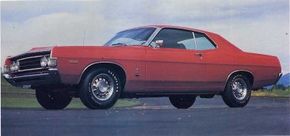Ford muscle cars counted among their ranks some of the better all-around performance machines of the supercar era, but it took some time for the blue oval boys to put it all together.
Ford in the 1960s had a bona-fide winner's reputation, but it was earned on the ovals of NASCAR, in international sports-car competition that included LeMans, in the open-wheel crucible of the Indy 500, and in organized drag-strip action. On the street, however, Ford's early muscle cars were usually heavier and underpowered compared to the best from GM, Dodge, and Plymouth.
Advertisement
Of course, you could argue that Ford didn't particularly need to worry about the true muscle car market since its Mustang was outselling every other sporty American car by a large margin. But that success wore thin as it became apparent that a reputation in stoplight street racing could translate into even more showroom sales.
Not that Ford was completely ill equipped for Main Street tussles. Its full-size Galaxies of the early '60s matched power ratings with their GM and Mopar counterparts. The Galaxie offered a high-performance 352-cid V-8 in 1960 and a 401-bhp triple-carb 390 in 1961. Displacement rose to 406 cubes in 1962, bringing with it 405 horses. In 1963 came the thundering 425-bhp 427 Galaxies.
The real hole in Ford's mid-'60s lineup was in the midsize-car ranks. This is where the heaviest street action was. A '66 Fairlane with the hi-po 289 or even the 335-bhp 390 V-8 was little match for a contemporary Chevy Chevelle SS 396 or, heaven forbid, a Hemi-powered Plymouth Satellite. Ford made a game response with a small batch of 427-powered Fairlanes, but they were very expensive and rarely seen.
When Ford finally cracked the muscle-car code, it made up for lost time. In 1968, Ford fitted a few Mustangs with a 390-horse 427, then replaced that engine at midyear with the 428 Cobra Jet V-8. Rated at a conservative 335 bhp, the Cobra Jet was a competitive powerplant with good street manners and a reasonable price. In a Mustang or midsize Torino, it made for some of the best-driving muscle cars of the 1960s.
Ford was even bolder in 1969, loosing a stampede of performance Mustangs: the Boss 302, Boss 429, Mach 1, and Shelby versions in GT 350 and GT 500 form. It responded to the Plymouth Road Runner with a low-budget midsize muscle machine, the Fairlane Cobra, which came standard with the 428 Cobra Jet V-8. It answered the aerodynamic Dodge Charger 500 and Daytona with the NASCAR-ready Fairlane-based Talladega.
The onslaught continued for 1970. Mustang continued strong. A redesigned Torino offered a new 370-bhp 429 CJ. And the new 351-cid "Cleveland" V-8 proved a tough rival in the smaller-displacement wars.
The last great Fords of the classic muscle car era arrived in 1971. The ultimate incarnation of the 351 Cleveland appeared in that year's 330-bhp Boss 351 Mustang. And a 429 was still available in both the Mustang and Torino.
Ford's exit from the golden age of muscle was sudden and complete. The 429 fell off Mustang's options list for 1972, although it was still available in the Torino, albeit in detuned, low-compression form.
Mustang, of course, continued in production uninterrupted, one of the precious few '60s-spawned nameplates to do so. It weathered a series of laughable attempts to recapture its performance glory, until in 1982, Ford restored its credibility with a new High Output 302-cid V-8.
That engine had just 157 bhp, but it signaled a steady climb back up the muscle ladder, an ascent that carried Mustang into the 21st century with looks and power that once again put Ford in the first ranks of American high-performance automobiles.
Return to Muscle Car Information Library.
For more cool information on muscle cars and on Ford, check out:
- Muscle cars came in many shapes and sizes. Here are features on more than 100 muscle cars, including photos and specifications for each model.
- Muscle cars created their own culture. To learn about it, read How Muscle Cars Work.
- Saddle up for the complete story of America's best-loved sporty car. How the Ford Mustang Works chronicles the legend from its inception in the early 1960s to today's all-new Mustang.
- Learn the history of the Ford Explorer, the world's best-selling SUV. Included are profiles of every model year.
For more profiles, photos, and specifications of Ford muscle cars, see:
- With three carbs, 406 cubes, and 406 bhp, the 1962 Ford Galaxie 406 proved full-size Fords could fly.
- The 1964 Ford Thunderbolt shoehorned a 427-cid V-8 into its midsize body and set out to defend the blue oval's honor.
- Shelbys were always the most charismatic Mustangs -- and with the 1967 Shelby GT 500, they finally got some big-block muscle.
- Even with a 335-bhp 428-cid V-8, the Mustang-based 1968 Shelby Cobra GT 500-KR wasn't really King of the Road, it just acted like it.
- At last, the original pony car could show its tail to the competition thanks to the 1968 Ford Mustang 428 Cobra Jet.
- The 1969 Ford Fairlane Cobra had a 428-cid V-8 standard and gave Ford lovers a low-buck midsize-muscle car.
- No muscle car promised more performance, or had more trouble delivering it, than the star-crossed 1969 Ford Mustang Boss 429.
- The 1969 Ford Talladega was the street version of the NASCAR racer so fast it got Plymouth loyalist Richard Petty to defect.
- It took a couple of Camaro guys to produce a beloved blue-oval classic, the taut and nimble 1970 Ford Mustang Boss 302.
- The 1970 Ford King Cobra survives as an example of a muscle car/NASCAR marriage gone wrong.
- Big size, big power, big fun, the 1970 Ford Torino Cobra uncoiled up to 375 bhp from its ram-air 429-cid V-8.
Advertisement
